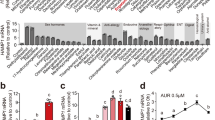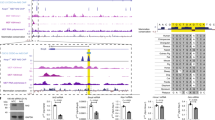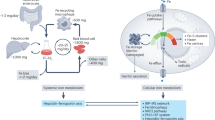Abstract
Juvenile hemochromatosis is an iron-overload disorder caused by mutations in the genes encoding the major iron regulatory hormone hepcidin (HAMP)1 and hemojuvelin (HFE2)2. We have previously shown that hemojuvelin is a co-receptor for bone morphogenetic proteins (BMPs) and that BMP signals regulate hepcidin expression and iron metabolism3,4. However, the endogenous BMP regulator(s) of hepcidin in vivo is unknown. Here we show that compared with soluble hemojuvelin (HJV.Fc), the homologous DRAGON.Fc is a more potent inhibitor of BMP2 or BMP4 but a less potent inhibitor of BMP6 in vitro. In vivo, HJV.Fc or a neutralizing antibody to BMP6 inhibits hepcidin expression and increases serum iron, whereas DRAGON.Fc has no effect. Notably, Bmp6-null mice have a phenotype resembling hereditary hemochromatosis, with reduced hepcidin expression and tissue iron overload. Finally, we demonstrate a physical interaction between HJV.Fc and BMP6, and we show that BMP6 increases hepcidin expression and reduces serum iron in mice. These data support a key role for BMP6 as a ligand for hemojuvelin and an endogenous regulator of hepcidin expression and iron metabolism in vivo.
This is a preview of subscription content, access via your institution
Access options
Subscribe to this journal
Receive 12 print issues and online access
$209.00 per year
only $17.42 per issue
Buy this article
- Purchase on Springer Link
- Instant access to full article PDF
Prices may be subject to local taxes which are calculated during checkout





Similar content being viewed by others
References
Roetto, A. et al. Mutant antimicrobial peptide hepcidin is associated with severe juvenile hemochromatosis. Nat. Genet. 33, 21–22 (2003).
Papanikolaou, G. et al. Mutations in HFE2 cause iron overload in chromosome 1q–linked juvenile hemochromatosis. Nat. Genet. 36, 77–82 (2004).
Babitt, J.L. et al. Bone morphogenetic protein signaling by hemojuvelin regulates hepcidin expression. Nat. Genet. 38, 531–539 (2006).
Babitt, J.L. et al. Modulation of bone morphogenetic protein signaling in vivo regulates systemic iron balance. J. Clin. Invest. 117, 1933–1939 (2007).
Pigeon, C. et al. A new mouse liver-specific gene, encoding a protein homologous to human antimicrobial peptide hepcidin, is overexpressed during iron overload. J. Biol. Chem. 276, 7811–7819 (2001).
Nemeth, E. et al. Hepcidin regulates cellular iron efflux by binding to ferroportin and inducing its internalization. Science 306, 2090–2093 (2004).
Nicolas, G. et al. The gene encoding the iron regulatory peptide hepcidin is regulated by anemia, hypoxia, and inflammation. J. Clin. Invest. 110, 1037–1044 (2002).
Nemeth, E. et al. IL-6 mediates hypoferremia of inflammation by inducing the synthesis of the iron regulatory hormone hepcidin. J. Clin. Invest. 113, 1271–1276 (2004).
Pietrangelo, A. Hereditary hemochromatosis. Biochim. Biophys. Acta 1763, 700–710 (2006).
Nemeth, E. et al. Hepcidin, a putative mediator of anemia of inflammation, is a type II acute-phase protein. Blood 101, 2461–2463 (2003).
Weiss, G. & Goodnough, L.T. Anemia of chronic disease. N. Engl. J. Med. 352, 1011–1023 (2005).
Andrews, N.C. Forging a field: the golden age of iron biology. Blood 112, 219–230 (2008).
Wang, R.H. et al. A role of SMAD4 in iron metabolism through the positive regulation of hepcidin expression. Cell Metab. 2, 399–409 (2005).
Shi, Y. & Massague, J. Mechanisms of TGF-beta signaling from cell membrane to the nucleus. Cell 113, 685–700 (2003).
Huang, F.W., Pinkus, J.L., Pinkus, G.S., Fleming, M.D. & Andrews, N.C. A mouse model of juvenile hemochromatosis. J. Clin. Invest. 115, 2187–2191 (2005).
Niederkofler, V., Salie, R. & Arber, S. Hemojuvelin is essential for dietary iron sensing, and its mutation leads to severe iron overload. J. Clin. Invest. 115, 2180–2186 (2005).
Truksa, J., Peng, H., Lee, P. & Beutler, E. Bone morphogenetic proteins 2, 4, and 9 stimulate murine hepcidin 1 expression independently of Hfe, transferrin receptor 2 (Tfr2), and IL-6. Proc. Natl. Acad. Sci. USA 103, 10289–10293 (2006).
Verga Falzacappa, M.V., Casanovas, G., Hentze, M.W. & Muckenthaler, M.U. A bone morphogenetic protein (BMP)-responsive element in the hepcidin promoter controls HFE2-mediated hepatic hepcidin expression and its response to IL-6 in cultured cells. J. Mol. Med. 86, 531–540 (2008).
Yu, P.B. et al. Dorsomorphin inhibits BMP signals required for embryogenesis and iron metabolism. Nat. Chem. Biol. 4, 33–41 (2008).
Samad, T.A. et al. DRAGON: a member of the repulsive guidance molecule-related family of neuronal- and muscle-expressed membrane proteins is regulated by DRG11 and has neuronal adhesive properties. J. Neurosci. 24, 2027–2036 (2004).
Babitt, J.L. et al. Repulsive guidance molecule (RGMa), a DRAGON homologue, is a bone morphogenetic protein co-receptor. J. Biol. Chem. 280, 29820–29827 (2005).
Samad, T.A. et al. DRAGON, a bone morphogenetic protein co-receptor. J. Biol. Chem. 280, 14122–14129 (2005).
Xia, Y., Babitt, J.L., Sidis, Y., Chung, R.T. & Lin, H.Y. Hemojuvelin regulates hepcidin expression via a selective subset of BMP ligands and receptors independently of neogenin. Blood 111, 5195–5204 (2008).
Solloway, M.J. et al. Mice lacking Bmp6 function. Dev. Genet. 22, 321–339 (1998).
Gehrke, S.G. et al. Expression of hepcidin in hereditary hemochromatosis: evidence for a regulation in response to the serum transferrin saturation and to non-transferrin-bound iron. Blood 102, 371–376 (2003).
Kautz, L. et al. Iron regulates phosphorylation of Smad1/5/8 and gene expression of Bmp6, Smad7, Id1, and Atoh8 in the mouse liver. Blood 112, 1503–1509 (2008).
Nicolas, G. et al. Lack of hepcidin gene expression and severe tissue iron overload in upstream stimulatory factor 2 (USF2) knockout mice. Proc. Natl. Acad. Sci. USA 98, 8780–8785 (2001).
Simic, P. et al. Systemically administered bone morphogenetic protein-6 restores bone in aged ovariectomized rats by increasing bone formation and suppressing bone resorption. J. Biol. Chem. 281, 25509–25521 (2006).
Xia, Y. et al. Repulsive guidance molecule RGMa alters utilization of bone morphogenetic protein (BMP) type II receptors by BMP2 and BMP4. J. Biol. Chem. 282, 18129–18140 (2007).
Knutson, M.D., Oukka, M., Koss, L.M., Aydemir, F. & Wessling-Resnick, M. Iron release from macrophages after erythrophagocytosis is up-regulated by ferroportin 1 overexpression and down-regulated by hepcidin. Proc. Natl. Acad. Sci. USA 102, 1324–1328 (2005).
Acknowledgements
We thank V. Rosen for kindly providing BMP2 for our study. We thank L.M. Russo for assistance with animal work. E.C. was supported in part by the Associazione Modenese per le Malattie del Fegato. S.V. was supported in part by the Croatian Ministry of Science, Education, and Sport. H.Y.L. was supported in part by US National Institutes of Health grants RO1 DK-69533 and RO1 DK-071837. J.L.B. was supported in part by National Institutes of Health grant K08 DK-075846 and by a Claflin Distinguished Scholar Award from the Massachusetts General Hospital.
Author information
Authors and Affiliations
Contributions
B.A., E.C., Y.X., H.Y.L. and J.L.B. designed experiments. B.A., E.C., Y.X., S.A.F., S.C., L.G. and J.L.B. performed experiments. B.A., E.C., Y.X., S.A.F. and J.L.B. analyzed data. M.D.K., A.P., S.V. and H.Y.L. contributed vital resources and reagents. B.A., E.C., Y.X., A.P., S.V., H.Y.L. and J.L.B. wrote or edited the paper. J.L.B. conceived and oversaw the entire project.
Corresponding author
Ethics declarations
Competing interests
J.L.B. and H.Y.L. have ownership interest in Ferrumax Pharmaceuticals, which has licensed technology from the Massachusetts General Hospital based on the work described here and in prior publications. Patent applications entitled “Methods and Composition to Regulate Iron Metabolism” and “Methods and Compositions for Regulating Iron Homeostasis by Modulation of BMP6” have been submitted by the Massachusetts General Hospital. S.V. is a Scientific Advisory Board member for Pfizer, Inc. and receives research funding from Genzyme Corp.
Supplementary information
Supplementary Text and Figures
Supplementary Figures 1–7 and Supplementary Table 1 (PDF 4994 kb)
Rights and permissions
About this article
Cite this article
Andriopoulos Jr, B., Corradini, E., Xia, Y. et al. BMP6 is a key endogenous regulator of hepcidin expression and iron metabolism. Nat Genet 41, 482–487 (2009). https://doi.org/10.1038/ng.335
Received:
Accepted:
Published:
Issue Date:
DOI: https://doi.org/10.1038/ng.335
This article is cited by
-
Synergistic immunotherapy targeting cancer-associated anemia: prospects of a combination strategy
Cell Communication and Signaling (2023)
-
Recent developments on BMPs and their antagonists in inflammatory bowel diseases
Cell Death Discovery (2023)
-
Iron, glucose and fat metabolism and obesity: an intertwined relationship
International Journal of Obesity (2023)
-
Intracellular labile iron is a key regulator of hepcidin expression and iron metabolism
Hepatology International (2023)
-
CREB-H is a stress-regulator of hepcidin gene expression during early postnatal development
Journal of Molecular Medicine (2023)



